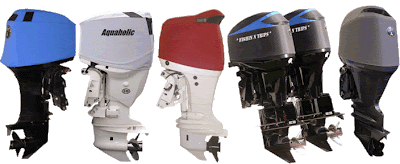To a thouroughbred sailor, the words 'motor' and 'sailing' in the same breath would be a big 'No-No'...but the Outboard Motor is nowadays a much required part of a sailboat nowadays, with most modern designs having one and many older ones accomodating one.
Why only sailboats, outboard motors are a much preferred option compared to stern-driven and shaft-driven engines on many smaller yachts and boats due to their ease in maintenance and flexibility in configuration.
Most of the world's best automobile and bike manufacturers lead the way in marine motors too, except for a few specialist like Mercury, Evinrude, Force etc.
When it comes to sailing, an outboard motor has become a must nowadays due to reasons such as safety and convenience. Also, due to pleasure being an important factor in sailing nowadays, at times sailors prefer to be motored back to shore if the winds are dead or conditions are not favoring them.
OUTBOARD MOTORS
Designed to be mounted at the stern (rear) of the craft, outboard motors for a boat are developed as a self-contained unit with engine and all related drive-train assembly, and a propeller. They are the most common motorized method of propelling small watercraft.
As well as providing propulsion, outboards provide steering control, as they are designed to pivot over their mountings and thus control the orientation of the propeller. The transmission leg in the water also acts as a rudder even when the propeller is not providing power.
When boats are out of service or being drawn through shallow waters, outboard motors can also be tipped forward over their mounts to elevate the propeller and transmission shaft out of the water to avoid accumulation of seaweed or hitting underwater hazards such as rocks.
HISTORY
One of the first practical outboard motors were designed and developed by Norwegian-American inventor Ole Evinrude in 1909.
Earlier, most of the outboard motors (OBMs) have used 2-stroke cycles with carburettor engines due to their simplicity, reliability, low-cost, high power-to-weight ratios (weight is obviously an important element to be considered at sea). The lightweight also helped as too much weight at the stern of the boats tends to impede their handling.
But due to the high specific fuel consumption and high emissions associated with traditional carburated two-stroke engines has led to the development of more sophisticated engines.
MODERN OBMs
Lately, manufacturers have marketed four-stroke cycle engines, at times with computer controls, fuel injection, variable camshaft timing, multiple valves per cylinder, and supercharging. Many others have made variations and modifications focused on developing computer controlled direct-injected two stroke engines. Both these designs can reduce fuel consumption and emissions markedly, especially at low engine speeds, albeit at the expense of greater cost and complexity.
Marine engines also benefit from the ability to draw an unlimited supply of cooling water from the environment; this eliminates the need for radiators and cooling fans, lowering complexity and weight.
A CONVENIENT OPTION
Most small OBMs are truly self-contained, with integral fuel tanks and controls mounted on the body of the motor and steered by a "tiller" directly connected to the motor. Such small motors are light and provide sufficient power to move a small dinghy at around 15 km/h. They are highly portable, able to be removed by simply loosening their mounting clamps on brackets.
At the same time, manufacturers have produced large outboard designs, with sufficient power to be used on boats as long as 9 metres or more. Manufacturers have also produced electric outboards. These are used for specialised applications, notably trolling for bass in the US, where their quietness and zero emissions outweigh the range deficiencies shared with electric cars. Diesel outboards are also available, but their weight and cost make them impractical for most purposes.
A few outboard motors have been produced with pump-jet propulsion replacing the conventional propeller. Like other types of pump-jet propulsion systems, they offer virtually no cavitation, giving the boat more maneuverability and the ability to operate in very shallow water. However, the low efficiency compared to propellers has seen them restricted to specialized applications.
OBM USE IN INDIA
In India, most of the manufacturers such as Yamaha, Suzuki, Evinrude have opened their shop since some time and have a good and reliable service network. At the current market maturity, OBMs are the preferred option due to their simplicity and costs. With the spurt in demand, most of the manufacturers are getting-in their international teams to train their Indian tie-ups with guidelines on optimum usage and maintenance.
At the same time, which OBM to go in for is always a debatable propostion. Obviously, purpose should be the key criteria for making a choice, but at times water conditions such as salinity and muddiness.
At GIIRA Yachts, our panel of advisors are able to provide the best option for your use, so do mail-in incase you have any technical queries or want to decide on the best OBM option for your purpose.
Mar 8, 2008
Anatomy of a Sail Boat - Part VIII : Outboard Motor (OBM)
Posted by
Paul Hyde
at
8:33 PM
![]()
Labels: outboard motors, yamaha outboard engines
Subscribe to:
Post Comments (Atom)
0 comments:
Post a Comment